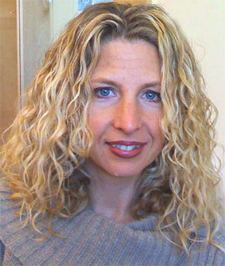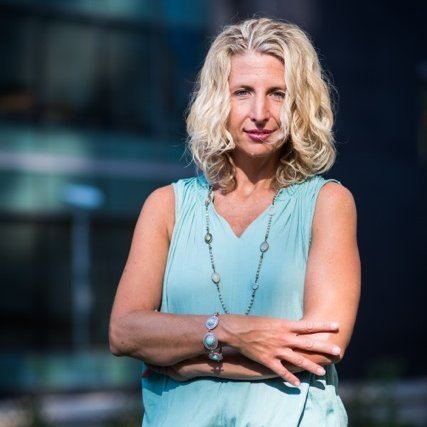Name Beth Stevens | ||
 | ||
Neuroscientist beth stevens 2015 macarthur fellow
Beth Stevens (b. 1969/1970) is an assistant professor in the Department of Neurology at Harvard Medical School and the F. M. Kirby Neurobiology Center at Boston Children’s Hospital. She has helped to identify the role of microglia in the “pruning” or removal of synaptic cells during brain development and has also determined that the impaired microglial function and abnormal activation of this pruning pathway could be responsible for diseases like autism, schizophrenia, and Alzheimer's.
Contents
- Neuroscientist beth stevens 2015 macarthur fellow
- Beth stevens clown emeli sande cover
- Early life and education
- Research
- Autism
- Neurology
- Awards
- References

In 2012, Stevens’ team published evidence that microglia 'eat' synapses, especially those that are weak and unused. The findings pinned down a new role for microglia in wiring the brain, indicating that adult neural circuitry is determined not only by the nerve cells but also by the brain’s immune cells, and helped to explain how the brain, which starts out with a surplus of neurons, trims some of the excess away. Neuron named the paper its most influential publication of 2012.

She continues to study the function of microglia in the healthy brain, most recently uncovering preliminary evidence that a certain protein serves as a ‘don’t eat me’ tag that protects synapses from being engulfed by microglia. She received a MacArthur Fellowship in 2015.

Beth stevens clown emeli sande cover
Early life and education

Beth Stevens was born in Brockton, Massachusetts to a mother who taught elementary school and a father who was the school’s principal.

Beth Stevens earned a B.S. in Biology (1993) from Northeastern University and a Ph.D. in Neuroscience from the University of Maryland, College Park (2003). Northeastern's co-op program gave Stevens the opportunity to work full-time in medical labs upon the completion of her coursework.
Stevens completed her postdoctoral fellowship at the Stanford University School of Medicine in 2008. At Stanford University School of Medicine, Stevens carried out research in astrocytes and how it helps neurons form synapses by triggering neurons to produce a protein that tags “eat-me” signals on immature synapses instead of mature ones.
Research
Currently, Stevens is a Research Associate in Neurology at Boston's Children's Hospital and Assistant Professor of Neurology, Harvard Medical School. Additionally, she is the Principal Investigator for the Stevens Lab, which "seeks to understand how neuron-glia communication facilitates the formation, elimination and plasticity of synapses—the points of communication between neurons—during both healthy development and disease." She is also an institute member of the Broad Institute.
Stevens' work has led her to the discovery of different aspects of microglia, and the implications of their relevancy to the neurological fields of disease in science.
Autism
Stevens is exploring the role of microglia in disorders such as autism. Several studies suggest that microglia are more active and more numerous in the brains of people with autism than in controls, and Stevens and her team are looking at whether the activity of microglia is altered during brain development in mouse models of autism. Her work suggests that adult diseases caused by deficient neural architecture (such as autism and schizophrenia) or states of neurodegeneration (such as Alzheimer’s or Huntington’s disease) may be the result of impaired microglial function and abnormal activation of the pruning pathway.
Neurology
Stevens Research Focus is on Glial cells and how they interact with neurons to communicate with another through synapses. She found it fascinating that little is known about glial but it makes up more than half of the brain. Her Research has explained that these Glial cells are like “PAC-MAN” clearing debris in the brain. This is crucial in protecting against diseases like Alzheimer's and Schizophrenia.
Glial plays an important in early brain development. At birth we are born with abundance synaptic connection and decrease with age. Brain cells talk to each other and decide which synapses are eliminated and which are strengthened and kept. Stevens Lab has a focus on how Gila decided which get to stick around. Steven’s Lab has already made it a point that synapsis impairment can occur way before we notice them happening, so it is important to note this connection for treatment for diseases. How are synapses lost? What makes synapses vulnerable? Alzheimer's is said to be the early birth purring somehow reactivating during adult brain.
Awards
Beth Stevens is not only a member of the John Merck Scholar Program, she has also received recognition for her discoveries and is the recipient of several awards. She has also given lectures and speeches as well as presentations in various elementary schools and universities. Among the awards she has received:
Stevens received the MacArthur Foundation's award of $625,000 in order to continue her studies on brain cells. Out of the 24 recipients of the award only 9, including Stevens, were women. Stevens received the Presidential Early Career Award for Scientists and Engineers (PECASE) in 2012. It is an award given to young scientists by the government. In October 2015, she gave 1 out of 4 Presidential lectures at the annual meeting of the Society for Neuroscience, the world's largest gathering of neuroscientists. She shares this honor with 3 other neuroscientists, two of which are Nobel laureates.
